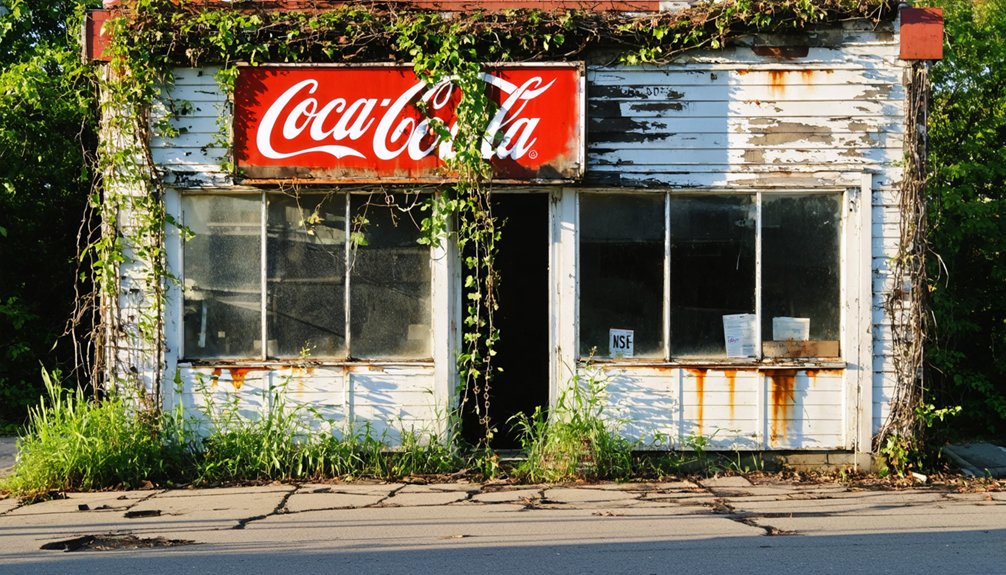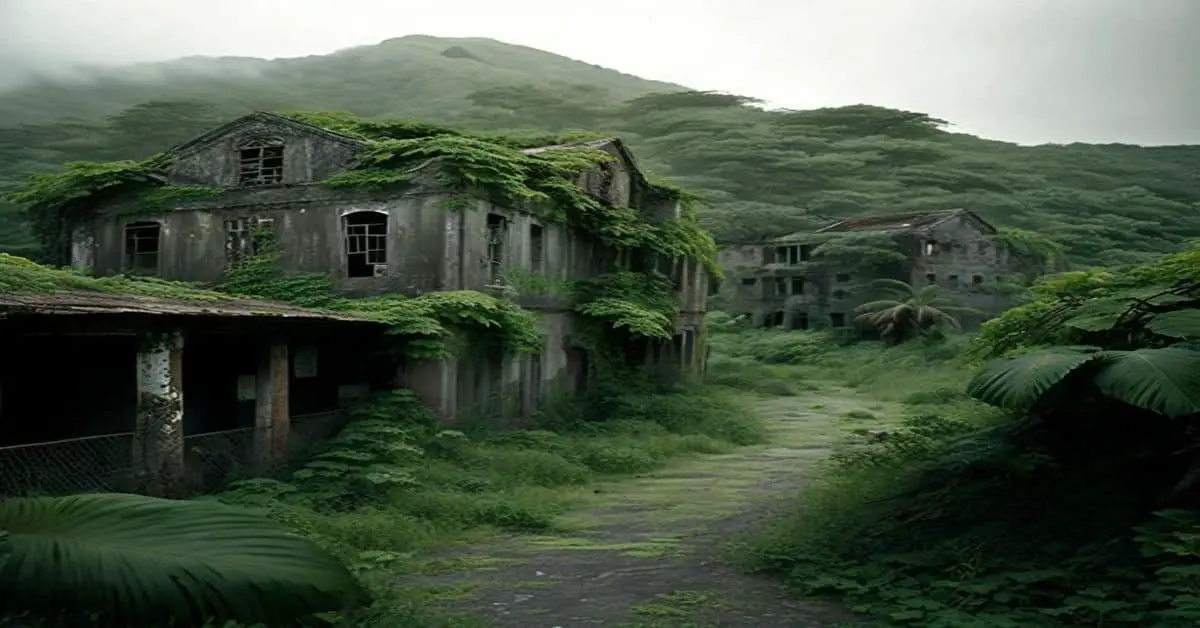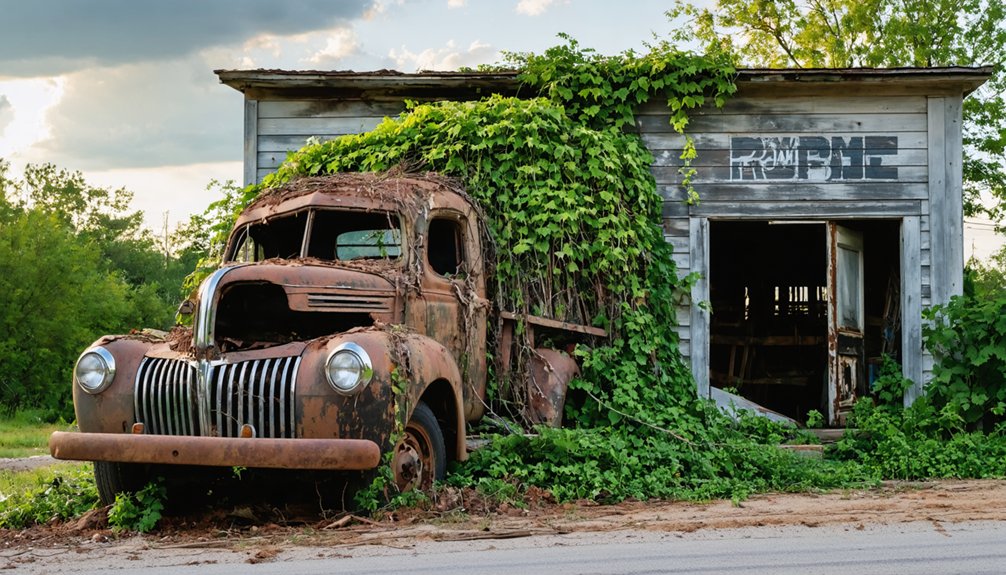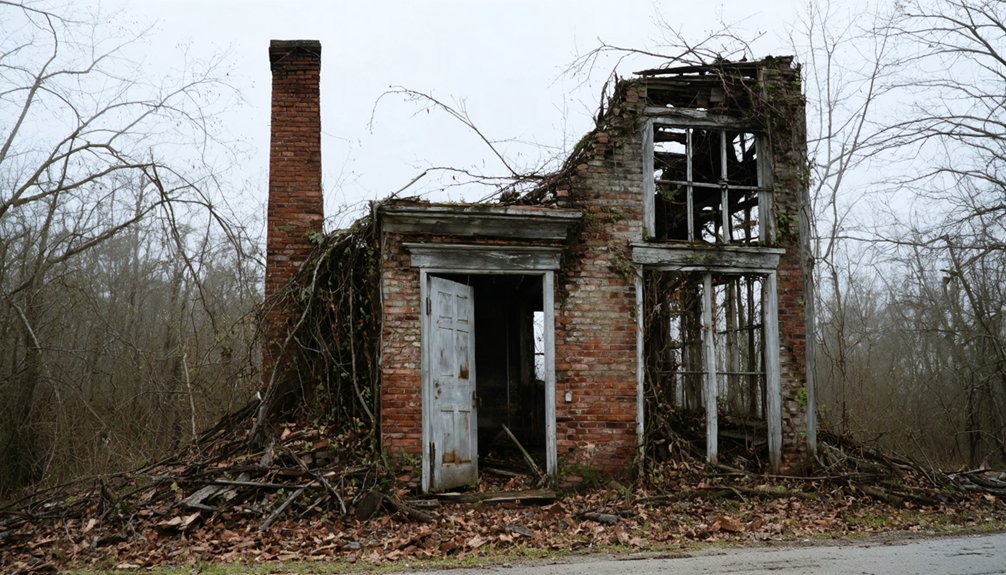You’ll find Brownville’s ghost town legacy in Alabama’s timber country, where it thrived as a company town from the 1920s to 1970s. Originally known as Sulpher Springs and “Hog Eye,” the Brown Wood Preserving Company established this close-knit community of 75-100 families who lived in modest frame houses. The town featured a commissary, post office, and community buildings, but by 1972, only three homes remained occupied. The story of its rise and fall reveals fascinating details about life in America’s lumber era.
Key Takeaways
- Brownville was a company town established by Brown Wood Preserving Company in the 1920s, housing 75-100 families in Alabama.
- The town reached its peak population of 250 residents between 1923-1950, with 40 frame houses and essential community facilities.
- All properties, including houses, store, and railroad, were owned by the company, with residents paying $1 per room monthly.
- Economic decline began in 1950 due to timber industry downturn, leading to population loss and eventual abandonment.
- By 1972, only three houses remained occupied, and the post office closure marked the town’s official end as a ghost town.
The Many Names of a Lost Town
While tracing the evolution of Brownville‘s identity, you’ll discover a settlement that carried several distinct names throughout its history.
The earliest name, Sulpher Springs, drew from the area’s natural mineral waters, while the peculiar moniker “Hog Eye” emerged from local folklore, though its name origins remain shrouded in mystery.
Known first as Sulpher Springs for its mineral-rich waters, the settlement later gained the enigmatic nickname “Hog Eye” through local lore.
Much like Choctaw Corner, this settlement served as a significant landmark for early settlers in the region.
You’ll find “Red Valley” appearing in historical accounts, though documentation for this name is sparse.
The settlement eventually became known as Brownville (sometimes spelled Brownsville), taking its name from the influential Brown family who operated timber and railroad interests in the region.
Though the town never incorporated, the Brown family’s economic presence solidified Brownville as the enduring name that’s most commonly referenced in historical records and ghost town directories today.
Today, with only three inhabited houses remaining, the town’s various historical names serve as echoes of a once-thriving community.
Life in the Lumber Company Era
As the Brown Wood Preserving Company established its dominance in the 1920s, Brownville emerged as a quintessential company town where life centered entirely around the lumber industry.
You’d find about 40 modest frame houses painted brown, rented to workers for just $1 per room monthly. The company culture fostered tight-knit relationships among 75-100 families who shared both workspace and living space.
Despite the lack of indoor plumbing, labor relations remained remarkably stable, with residents finding contentment in their self-sufficient lifestyle. Residents maintained communal gardens and livestock on their company-provided land.
The community was originally known as Red Valley due to its distinctively painted houses.
The company owned everything – from the houses to the store, and even operated its own railroad nicknamed the M and G line.
Your daily routine would’ve revolved around the sawmill’s whistle, as the plant’s operations dictated the rhythm of community life.
From Boom to Bust: A Timeline
In Brownville’s heyday from 1923 to 1950, you’d find a bustling riverside community where steamboats lined the docks and timber operations kept the M and G railroad humming.
You’ll notice the town’s stability relied heavily on its single-landlord rental system, which allowed for quick population shifts when river trade declined after 1950.
When the commissary burned in the 1950s and the post office closed in 1972, you’re looking at the final chapter of Brownville’s transformation from a thriving lumber town to an eastern ghost town. Like many Dead Towns of Alabama, Brownville’s population dwindled to less than one-fifth of its peak size.
Rise and Prosperity (1923-1950)
During the mid-1920s, Brownville transformed from a fledgling settlement into a thriving company town under the Brown family’s careful orchestration. At its peak, you’d find 250 residents living in over 40 red-painted homes, all connected through their ties to the timber industry and shared community spaces.
The Browns built more than just a workforce – they created a self-sustaining haven. You’d have found everything needed for daily life: a well-stocked commissary, an on-site doctor, and a community building that doubled as both church and social center. Like other towns called Brownville across America, this settlement developed its own distinct identity and character.
The M&G Railroad, constructed by the family, linked Brownville to Buhl, ensuring lumber could move efficiently to market. Community resilience flourished as residents enjoyed hunting, fishing, and organized activities that strengthened their social bonds through the 1940s.
Decline and Abandonment (1950-1972)
The sudden unraveling of Brownville’s tight-knit community began in 1950, when the Brown Lumber Company’s declining timber operations triggered a domino effect of closures.
As economic instability gripped the town, you’d have witnessed an unprecedented population migration that saw nearly 250 residents leave their modest wood-frame homes almost overnight.
Unlike typical ghost towns that decline gradually, Brownville’s fate was sealed by its unique situation – all homes were rental properties owned by a single landlord.
When the M and G railroad service ended and the timber industry collapsed, residents lost both jobs and transportation options.
By the early 1970s, only three houses remained occupied.
The post office’s closure in 1972 marked Brownville’s official end, as nature reclaimed the abandoned buildings and bulldozers cleared unsafe structures.
Daily Life in the Company Town
You’ll find life in Brownville revolved around the Brown Wood Preserving Plant, where workers rented simple frame houses for $1 per room monthly and adapted to homes without indoor plumbing.
To avoid any confusion with locations, residents would specify “Brownville, Alabama” when corresponding with others since multiple towns shared similar names.
Your ancestors who lived here would have experienced a tight-knit community where most social activities centered on fellow plant workers and their families.
The weekly Saturday bus service to Fayette and Tuscaloosa offered residents their main connection to the outside world, providing access to goods and entertainment beyond what was available in their isolated company town.
Housing and Living Quarters
Life in Brownville’s company town revolved around more than 40 modest frame houses, strategically arranged along dirt roads near the Brown Wood Preserving Plant. The stark housing inequalities reflected the era’s racial segregation, with white families occupying four-room houses while Black families lived in smaller shotgun shacks. Each family paid $1 per room monthly for their creosote-treated homes.
Under strict company control, you’d find basic accommodations without indoor plumbing, though the town offered essential amenities like a store, theater, church, and school.
While the company provided these necessities and maintained the properties, most residents considered it an improvement over their previous homes in primitive log cabins.
Today, many of these original structures have crumbled or been dismantled, marking the end of this unique housing arrangement.
Community Social Activities
Despite Brownville’s remote location, residents forged a vibrant social life centered around weekly gatherings, church functions, and shared outdoor activities. You’d find families congregating at community centers, participating in recreational sports, and strengthening their bonds through informal neighborhood get-togethers. Residents kept their homes unlocked, demonstrating the deep trust built through their close-knit bonds.
The town’s social calendar revolved around Saturday bus trips to Tuscaloosa, where you could shop and enjoy city entertainment. Church services served as the cornerstone of community life, while schools became natural gathering spots for families. The community’s roots in mining operations shaped the working-class culture that defined daily interactions.
Without indoor plumbing, daily routines often moved outdoors, creating organic opportunities for socializing. You’d witness children playing together while parents chatted, fostering the tight-knit atmosphere typical of company towns.
Though isolated, Brownville’s residents made the most of their shared experiences, building lasting connections through simple, meaningful interactions.
Commissary and Basic Needs
Beyond the social gatherings, Brownville’s residents relied on a carefully structured system of basic necessities centered around the company commissary. You’d find daily essentials available through local vendor stations or the commissary operations, vital for sustaining the 40+ households who called Brownville home.
With the nearest towns of Fayette and Tuscaloosa requiring significant travel, you couldn’t simply pop out for groceries whenever needed.
While paying just $1 per room for housing, you’d manage most of your shopping within the town’s confined economy. The commissary stocked basic goods from groceries to hardware, creating a self-contained system where your wages typically circulated back to the company.
A weekly Saturday bus to Fayette offered your only regular access to outside markets.
The Heart of the Community
Community spirit thrived in Brownville during its heyday, when 250 residents shared their lives across 40 company-owned homes.
You’d find the town’s social cohesion centered around the community building and church, where families gathered regularly to strengthen their bonds. The surrounding wilderness offered abundant hunting and fishing opportunities, creating shared outdoor experiences that brought neighbors together.
Unlike many ghost towns west of the Mississippi, Brownville’s story is unique to the Southeast. The town’s single-landlord structure meant everyone lived under similar circumstances, fostering a tight-knit atmosphere.
While the lumber and wood preserving companies provided steady employment, they also created a shared identity among workers. Yet this same interconnectedness would later contribute to the town’s swift decline when industry failed, leaving only three inhabited homes today.
Workers, Families, and Social Bonds
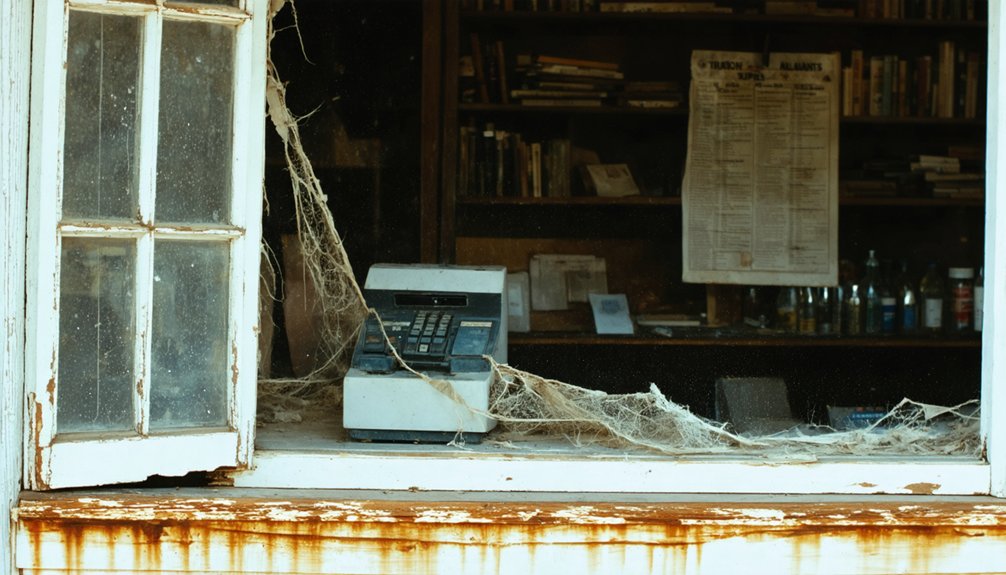
While the Brown Wood Preserving Company provided the town’s economic backbone, it was the close-knit relationships among workers and their families that defined Brownville’s social fabric.
You’d find about 250 residents living in modest wooden houses, each paying just $1 per room monthly to the Brown family. Despite the lack of indoor plumbing, these homes fostered remarkable community resilience.
The town’s family legacies were woven through shared experiences – from hunting and fishing adventures to bus trips into Tuscaloosa for shopping.
Life in Brownville flowed through shared moments – families bonded over outdoor adventures and weekend shopping excursions to the city.
For six vibrant decades, workers didn’t just share a workplace; they shared lives. Though specific social gatherings aren’t well-documented, former residents’ enduring memories paint a picture of a tight-knit community where neighbors became extended family, creating bonds that outlasted the town itself.
Architecture and Infrastructure
In the early 1920s, J. Graham Brown and his brother established Brownville’s architectural footprint with their wood preserving plant at its heart.
You’ll find that the town’s abandoned structures tell a story of industrial heritage, with the plant’s distinctive creosote-treated buildings dominating the landscape.
The residential area featured two distinct housing zones: four-room frame dwellings for white workers east of the plant, and smaller shotgun-style homes for Black workers to the west.
All houses lacked indoor plumbing and were built within a concentrated three-year period.
The Brown Lumber Company operated as one of the town’s primary employers, contributing significantly to local development.
The town’s infrastructure included essential community buildings: a company store, theater, church, school, and ballfield.
A company-owned railroad, the M and G line, connected Brownville to Buhl, serving both industrial and passenger needs.
Economic Forces Behind the Decline
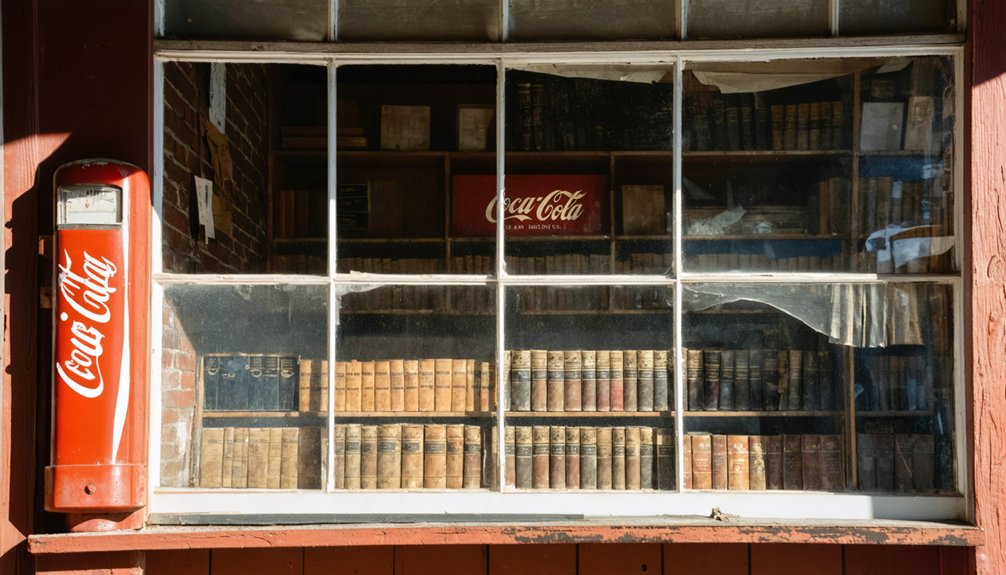
Since Brownville’s fate rested entirely in the hands of the Brown family’s timber enterprises, you’ll find that its economic collapse proved swift and devastating.
The town’s resource dependency centered on the Brown Lumber Company, Brown Wood Preserving Company, and their M and G rail line, creating a dangerous economic vulnerability.
You’ll notice that unlike other ghost towns that declined gradually, Brownville’s population vanished almost overnight when the timber industry faltered.
Regional shifts didn’t help – Birmingham’s industrial growth drew investments away, while changes in forestry practices and transportation routes diminished Brownville’s relevance.
When the post office closed in 1972 after 46 years of operation, it marked the final chapter of a community that couldn’t survive beyond its single-industry foundation.
Preserving the Town’s Memory
You’ll find the most authentic record of Brownville’s history through the oral histories of its former residents, whose firsthand accounts capture the essence of daily life in this once-thriving company town.
Local historical societies and community groups are working to collect and preserve these personal narratives before they’re lost to time.
Your participation in documenting family stories and contributing to historical documentation projects can help guarantee that Brownville’s legacy endures for future generations.
Oral Histories Matter Now
While physical structures crumble and written records fade, oral histories have become the essential lifeline for preserving Brownville’s rich heritage.
You’ll find that these oral traditions capture the essence of daily life – from hunting and fishing excursions to vibrant social gatherings – in ways that formal documentation simply can’t match.
Through memory preservation efforts, you’re able to understand how the community’s social fabric unraveled when the Brown companies ended worker housing rentals.
Former residents like Joe Langston and Sue Miller share stories about the church, hotel, and commissary that once anchored their society.
These personal accounts help you trace Brownville’s evolution from Sulpher Springs to Hog Eye to Red Valley, revealing how a thriving company town transformed into the quiet ghost town you’d find today.
Historical Documentation Projects
Through dedicated preservation initiatives, Brownville’s history lives on in a rich tapestry of documented records.
You’ll find detailed accounts in publications like “The Brownville Story” and historian John L. Hunt’s thorough works, which capture the town’s unique status as an East-of-Mississippi ghost town.
Historical preservation efforts have gathered company records, revealing intimate details of daily life, from employee housing assignments to racial segregation practices in the community.
Community documentation spans multiple sources, including postal records, census data, and the Brown Wood Preserving Company archives.
You can explore photographs showing the distinctive creosote-treated homes and access digital collections that preserve population statistics, economic data, and personal stories from former residents.
These carefully maintained records guarantee Brownville’s legacy endures for future generations.
Legacy of an Alabama Ghost Town
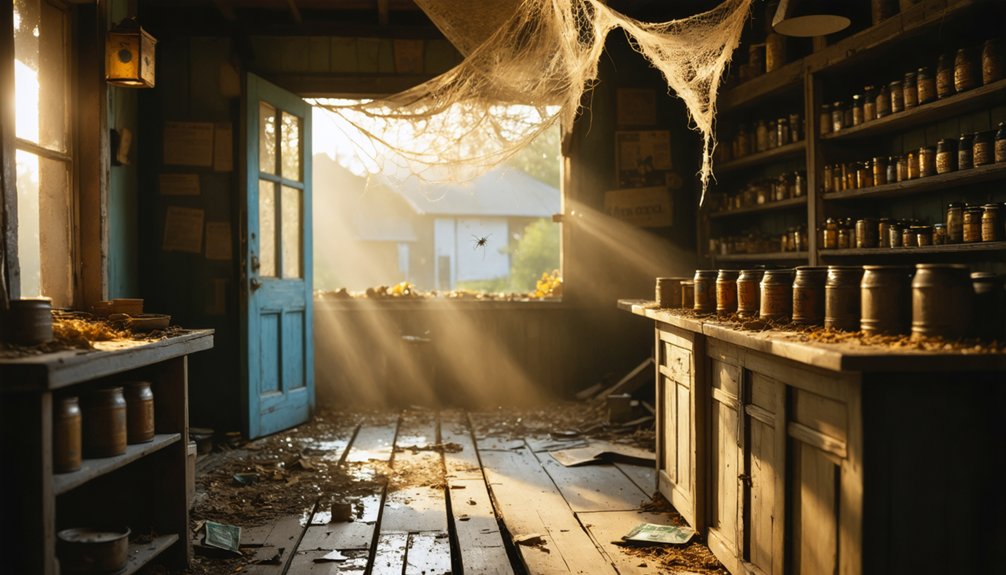
Although Brownville’s physical structures have largely vanished, its legacy persists as a remarkable example of an eastern ghost town that tells the story of Alabama’s timber industry and company town era.
Unlike western ghost towns, Brownville’s cultural significance lies in how quickly its tight-knit community dispersed when improved transportation freed workers from company housing.
You’ll find industrial nostalgia in the memories of former residents who recall a self-sufficient town where 75 to 100 families once thrived around the Brown Lumber Company.
Today, with only three inhabited houses remaining, Brownville stands as a poignant reminder of how changing economics and transportation can transform communities.
Its story reflects broader patterns of rural depopulation and the end of the company town era in the American South.
Frequently Asked Questions
Are There Any Remaining Accessible Structures or Ruins in Brownville Today?
You won’t find confirmed accessible structures today, though historic preservation efforts haven’t documented any ruins of architectural significance. You’ll need to contact local historical societies for potential site locations.
What Dangerous Wildlife or Hazards Should Visitors Be Aware Of?
Like walking through Jurassic Park, you’ll need to watch for venomous snakes, alligators near water, and wild mammals. Hidden dangers include unstable structures, dense overgrowth, and disease-carrying insects.
Is Permission Required to Visit the Former Town Site?
Yes, you’ll need permission since it’s private property. While there aren’t official visitation guidelines for this historically significant site, you must contact local landowners before exploring the remaining structures.
Were Any Movies or Television Shows Ever Filmed in Brownville?
You won’t find any recorded film history or television productions shot in this location. Despite local legends and its ghost town atmosphere, there’s no evidence of movies being made here.
Did Any Notable Crimes or Mysterious Events Occur in Brownville?
You won’t find any documented unsolved mysteries or ghost sightings here. Historical records show this was a peaceful company town that simply faded away due to economic changes, not criminal activity.
References
- https://en.wikipedia.org/wiki/Brownville
- https://www.brownvillealabama.com/bvillestory2.htm
- https://digitalalabama.com/alabama-ghost-towns/alabama-ghost-towns/9449
- https://ahc.alabama.gov/properties/cahawba/cahawba.aspx
- https://www.brownvillealabama.com/bvillestory7.htm
- https://www.tripadvisor.com/ShowUserReviews-g30754-d3405413-r702542512-Old_Cahawba_Archaeological_Park-Orrville_Alabama.html
- https://freepages.history.rootsweb.com/~gtusa/usa/al.htm
- http://abnf.co/AL-brownville_
- https://www.ghostlyworld.org/places/brownville-alabama/
- https://www.wikiwand.com/en/articles/Brownville
